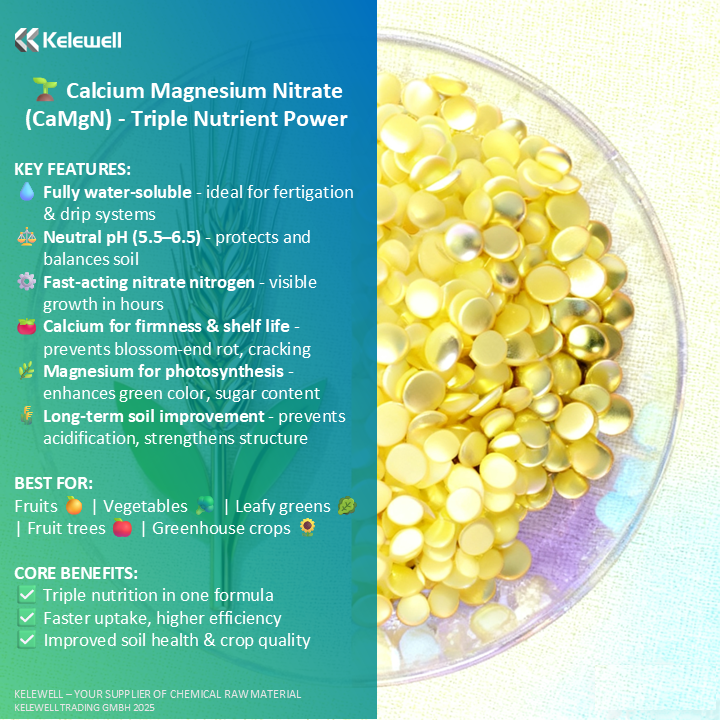Calcium Magnesium Nitrate: The Multi-Nutrient Fertilizer Powering Modern Efficient Agriculture
- Camille W.

- Nov 5
- 3 min read
In the pursuit of efficient and high-quality agriculture, scientific fertilization is not only the core to improving crop yields but also the key to enhancing produce quality and protecting soil ecology. Calcium magnesium nitrate, a compound medium-element fertilizer with both “quick-acting” and “multi-functional” characteristics, is becoming increasingly popular as it provides three essential nutrients—nitrogen (N), calcium (Ca), and magnesium (Mg)—in one product. This advantage allows it to gradually replace traditional single-nutrient fertilizers, making it a favorite in facility agriculture and high-value crop cultivation.
This article provides a comprehensive overview of calcium magnesium nitrate—from its composition and features to its core functions, comparative advantages, and scientific application guidelines—uncovering its logic and role in modern agriculture.
I. Understanding Calcium Magnesium Nitrate: Beyond “N-Ca-Mg in One,” with Standardized Composition Assurance
Calcium magnesium nitrate is not a simple mixture of calcium nitrate and magnesium nitrate, but an industrially formulated compound designed according to crop nutrient demands. High-quality products typically feature:• Nutrient content: nitrate nitrogen (NO₃⁻-N) ≥ 11%, calcium oxide (CaO) ≥ 6.5%, magnesium oxide (MgO) ≥ 11.5%.• Key characteristics:
Fully water-soluble – dissolves over 150 g/L (at 20 °C) with clear solution and no residue; compatible with drip, sprinkler, and foliar systems, avoiding clogging.
Neutral pH – solution pH 5.5–6.5; does not acidify soil and can neutralize slight acidity, maintaining soil pH at the optimal 6.0–7.5 range.
Low hygroscopicity – improved anti-caking properties allow storage over 6 months under 60% humidity without clumping.
Free from harmful ions – chloride-, sulfate-, and sodium-free, ensuring high safety for chloride-sensitive crops such as tobacco, strawberry, and citrus.
II. Four Core Functions: From Crop Growth to Soil Health
Rapid Nitrogen Supply: Provides 100% nitrate nitrogen, directly absorbed by roots and leaves within hours, boosting photosynthesis and growth efficiency.
Targeted Calcium Supply: Strengthens cell walls, prevents physiological disorders (e.g., blossom-end rot in tomatoes, bitter pit in apples), and extends shelf life.
Active Magnesium Supplementation: Restores chlorophyll function, enhances photosynthesis, and improves sugar accumulation in fruits.
Soil Conditioning: Neutralizes acidity, improves soil structure, reduces nutrient fixation, and inhibits harmful pathogens—promoting long-term soil fertility.
III. Comparison: Calcium Magnesium Nitrate vs. Traditional Fertilizers
Comparison Dimension | Calcium Magnesium Nitrate | Calcium Nitrate | Magnesium Sulfate | Urea |
Nutrient Completeness | N, Ca, Mg in one | N, Ca only | Mg, S only | N only |
Absorption Efficiency | Quick absorption (1–2 h) | Slower (needs Mg supplement) | 3–5 days conversion | 5–7 days conversion |
Soil Impact | Neutral, improves structure | May cause Mg deficiency | Risk of acidification | Leads to acidification |
Crop Suitability | All crops, esp. Cl-sensitive | Ca-demanding crops | Mg-demanding crops | N-demanding crops |
Overall Cost | Higher per use but lower total cost | Frequent reapplication | Needs combination | Needs supplement |
IV. Application Guidelines: Tailor by Crop and Growth Stage
Fruits & Vegetables (Tomato, Cucumber, Strawberry, Grape):
Base 5–10 kg/acre before planting; fertigation 2–5 kg every 10–15 days; foliar spray 0.3% during fruit enlargement.
Leafy Greens (Spinach, Lettuce):
Early-stage fertigation 0.5%; foliar 0.2–0.3% every 7–10 days for greener, heavier leaves.
Fruit Trees (Apple, Citrus):
Fertigation 3–5 kg/acre from bud to fruit set; increase to 4–6 kg during fruit enlargement.
Field Crops (Rice, Corn):
Fertigation 3–4 kg/acre during heading or grain filling; foliar 0.3% to improve yield and stress resistance.
V. Precautions: Avoid the Three “Pitfalls”
Do not mix with phosphates (e.g., MKP, MAP) directly to prevent insoluble precipitates.
Avoid overapplication to prevent salt injury; typically ≤ 5 kg per acre each time.
Storage and spraying: Keep sealed, apply in early morning or evening to maximize absorption.
Crop-specific care: Reduce use for nitrogen-sensitive crops (tobacco, potato); adjust soil pH for acid-loving crops (blueberry, azalea).
Conclusion:
Choosing calcium magnesium nitrate is not about following trends—it’s about scientific precision. It meets modern agriculture’s goals of efficiency, quality, and sustainability by addressing the limitations of traditional fertilizers: single nutrients, low utilization, and soil degradation. When applied based on crop type, soil condition, and growth stage, calcium magnesium nitrate becomes a true “multi-nutrient ally,” empowering farmers to achieve higher yields and better quality sustainably.




Comments